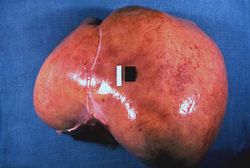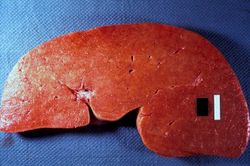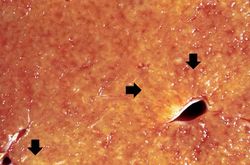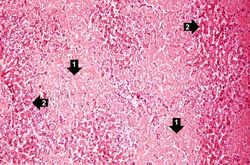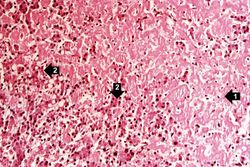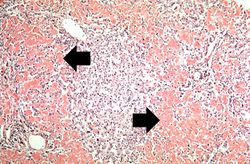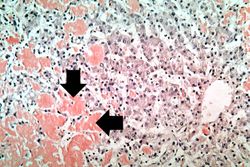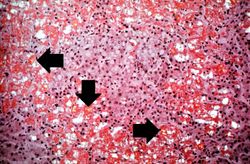Difference between revisions of "IPLab:Lab 6:Amyloidosis"
Seung Park (talk | contribs) |
|||
| Line 19: | Line 19: | ||
File:IPLab6Amyloid11.jpg|This photomicrograph of the tongue demonstrates extensive amyloid deposits (1) separating the skeletal muscle fibers of the tongue. In many cases the amyloid encircles the muscle fibers (2) and these muscle fibers are atrophied. | File:IPLab6Amyloid11.jpg|This photomicrograph of the tongue demonstrates extensive amyloid deposits (1) separating the skeletal muscle fibers of the tongue. In many cases the amyloid encircles the muscle fibers (2) and these muscle fibers are atrophied. | ||
</gallery> | </gallery> | ||
| + | |||
| + | == Study Questions == | ||
| + | * <spoiler text="What type of amyloid is this?">This is secondary amyloidosis because it is secondary to a chronic inflammatory condition. This would be an AA type of amyloid.</spoiler> | ||
| + | * <spoiler text="What is SAA protein, where is it produced, and what stimulates its production?">Serum amyloid-associated" protein is a protein produced by the liver when stimulated by interleukins 1 and 6.</spoiler> | ||
| + | * <spoiler text="What does hyaline mean?">Hyaline is a descriptive histologic term which refers to an alteration within cells or in the extracellular space which has a homogeneous, glassy, pink appearance in routine histologic sections stained with hematoxylin and eosin. | ||
| + | |||
| + | Amyloid is homogeneous, glassy, and pink in appearance; thus, we describe amyloid as having a hyaline appearance.</spoiler> | ||
| + | * <spoiler text=" ">Hyaline is a descriptive histologic term which refers to an alteration within cells or in the extracellular space which has a homogeneous, glassy, pink appearance in routine histologic sections stained with hematoxylin and eosin. | ||
| + | |||
| + | Amyloid is homogeneous, glassy, and pink in appearance; thus, we describe amyloid as having a hyaline appearance.</spoiler> | ||
{{IPLab 6}} | {{IPLab 6}} | ||
[[Category: IPLab:Lab 6]] | [[Category: IPLab:Lab 6]] | ||
Revision as of 15:49, 21 August 2013
Clinical Summary[edit]
This 46-year-old white male with a long-standing history of rheumatoid arthritis was admitted for treatment of pneumonia. Subsequently, complications associated with lung abscesses, empyema, and septicemia led to the patient's death.
Autopsy Findings[edit]
The liver weighed 2600 grams. It was yellowish-tan in color and cut with difficulty (fibrosis?). No other pathological changes were noted except for pneumonia and lung abscesses.
Images[edit]
This is a gross photograph of kidney from this case. Note the pale yellow material within the cortex (arrows). This is indicative of amyloid within the cortex and the glomeruli. Also note that there are multiple red spots in the cortex. These represent congested glomeruli due to the vascular compromise produced by the amyloid.
Study Questions[edit]
In alcoholics, aspiration pneumonia is common--bacteria enter the lung via aspiration of gastric contents.
An abscess is a collection of pus (white blood cells) within a cavity formed by disintegrated tissue.
A normal liver weighs 1650 grams (range: 1500 to 1800 grams).
